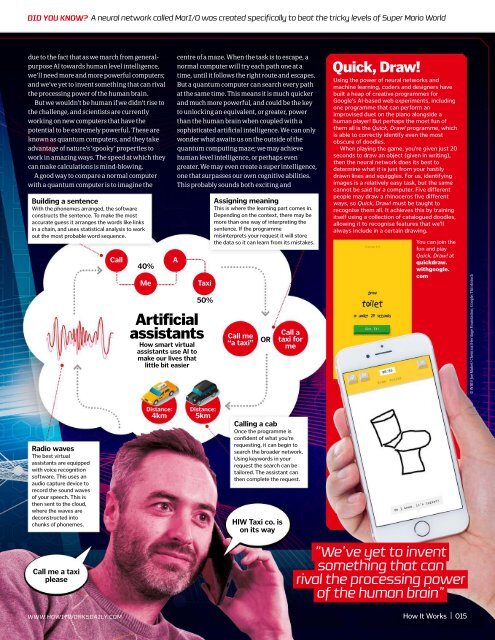How_It_Works_Issue_99_2017
Create successful ePaper yourself
Turn your PDF publications into a flip-book with our unique Google optimized e-Paper software.
DID YOU KNOW? A neural network called MarI/O was created specifically to beat the tricky levels of Super Mario World<br />
due to the fact that as we march from generalpurpose<br />
AI towards human level intelligence,<br />
we’ll need more and more powerful computers;<br />
and we’ve yet to invent something that can rival<br />
the processing power of the human brain.<br />
But we wouldn’t be human if we didn’t rise to<br />
the challenge, and scientists are currently<br />
working on new computers that have the<br />
potential to be extremely powerful. These are<br />
known as quantum computers, and they take<br />
advantage of nature’s ‘spooky’ properties to<br />
work in amazing ways. The speed at which they<br />
can make calculations is mind-blowing.<br />
A good way to compare a normal computer<br />
with a quantum computer is to imagine the<br />
Building a sentence<br />
With the phonemes arranged, the software<br />
constructs the sentence. To make the most<br />
accurate guess it arranges the words like links<br />
in a chain, and uses statistical analysis to work<br />
out the most probable word sequence.<br />
Call<br />
40%<br />
Me<br />
A<br />
<strong>How</strong> smart virtual<br />
assistants use AI to<br />
make our lives that<br />
little bit easier<br />
centre of a maze. When the task is to escape, a<br />
normal computer will try each path one at a<br />
time, until it follows the right route and escapes.<br />
But a quantum computer can search every path<br />
at the same time. This means it is much quicker<br />
and much more powerful, and could be the key<br />
to unlocking an equivalent, or greater, power<br />
than the human brain when coupled with a<br />
sophisticated artificial intelligence. We can only<br />
wonder what awaits us on the outside of the<br />
quantum computing maze; we may achieve<br />
human level intelligence, or perhaps even<br />
greater. We may even create a super intelligence,<br />
one that surpasses our own cognitive abilities.<br />
This probably sounds both exciting and<br />
Taxi<br />
50%<br />
Artificial<br />
assistants<br />
Assigning meaning<br />
This is where the learning part comes in.<br />
Depending on the context, there may be<br />
more than one way of interpreting the<br />
sentence. If the programme<br />
misinterprets your request it will store<br />
the data so it can learn from its mistakes.<br />
Call me<br />
“a taxi”<br />
OR<br />
Call a<br />
taxi for<br />
me<br />
Quick, Draw!<br />
Using the power of neural networks and<br />
machine learning, coders and designers have<br />
built a heap of creative programmes for<br />
Google’s AI-based web experiments, including<br />
one programme that can perform an<br />
improvised duet on the piano alongside a<br />
human player! But perhaps the most fun of<br />
them all is the Quick, Draw! programme, which<br />
is able to correctly identify even the most<br />
obscure of doodles.<br />
When playing the game, you’re given just 20<br />
seconds to draw an object (given in writing),<br />
then the neural network does its best to<br />
determine what it is just from your hastily<br />
drawn lines and squiggles. For us, identifying<br />
images is a relatively easy task, but the same<br />
cannot be said for a computer. Five different<br />
people may draw a rhinoceros five different<br />
ways, so Quick, Draw! must be taught to<br />
recognise them all. <strong>It</strong> achieves this by training<br />
itself using a collection of catalogued doodles,<br />
allowing it to recognise features that we’ll<br />
always include in a certain drawing.<br />
You can join the<br />
fun and play<br />
Quick, Draw! at<br />
quickdraw.<br />
withgoogle.<br />
com<br />
© WIKI/ Joe Mabel/ Chemical Heritage Foundation; Google; Thinkstock<br />
Radio waves<br />
The best virtual<br />
assistants are equipped<br />
with voice recognition<br />
software. This uses an<br />
audio capture device to<br />
record the sound waves<br />
of your speech. This is<br />
then sent to the cloud,<br />
where the waves are<br />
deconstructed into<br />
chunks of phonemes.<br />
Distance:<br />
4km<br />
Distance:<br />
5km<br />
Calling a cab<br />
Once the programme is<br />
confident of what you’re<br />
requesting, it can begin to<br />
search the broader network.<br />
Using keywords in your<br />
request the search can be<br />
tailored. The assistant can<br />
then complete the request.<br />
HIW Taxi co. is<br />
on its way<br />
Call me a taxi<br />
please<br />
“We’ve yet to invent<br />
something that can<br />
rival the processing power<br />
of the human brain”<br />
WWW.HOWITWORKSDAILY.COM<br />
<strong>How</strong> <strong>It</strong> <strong>Works</strong> | 015


















